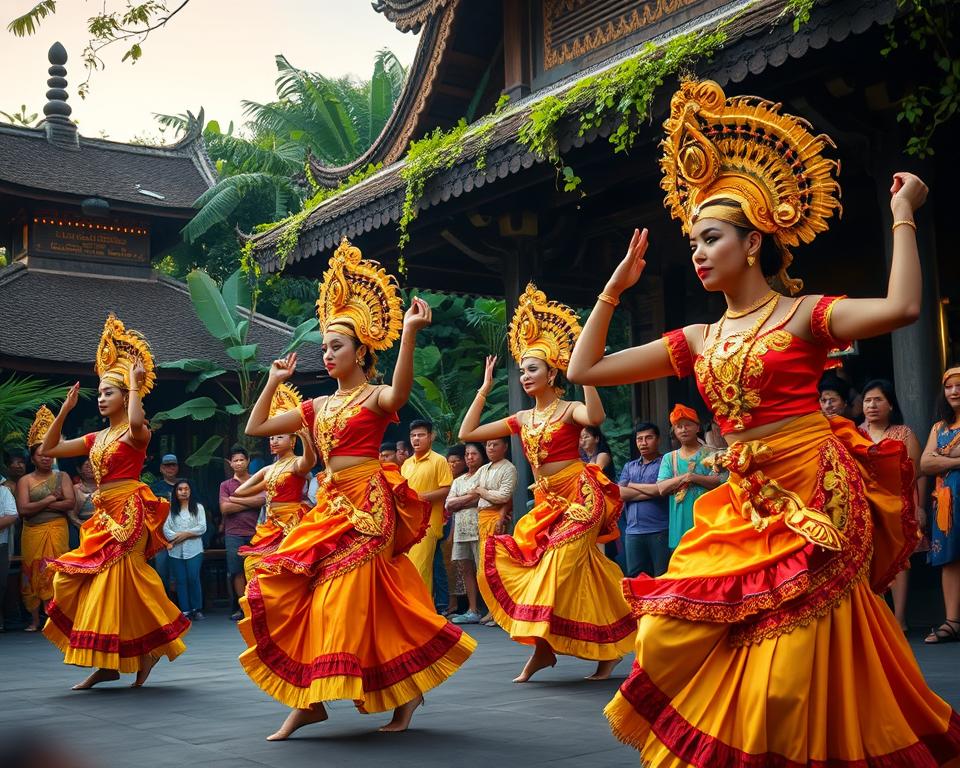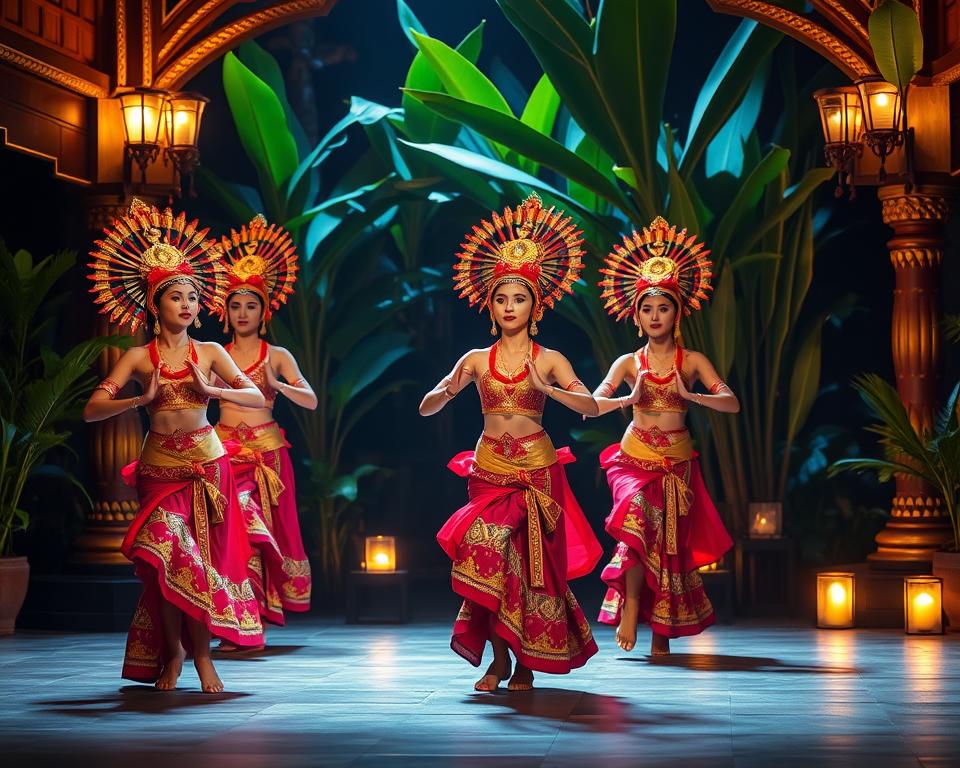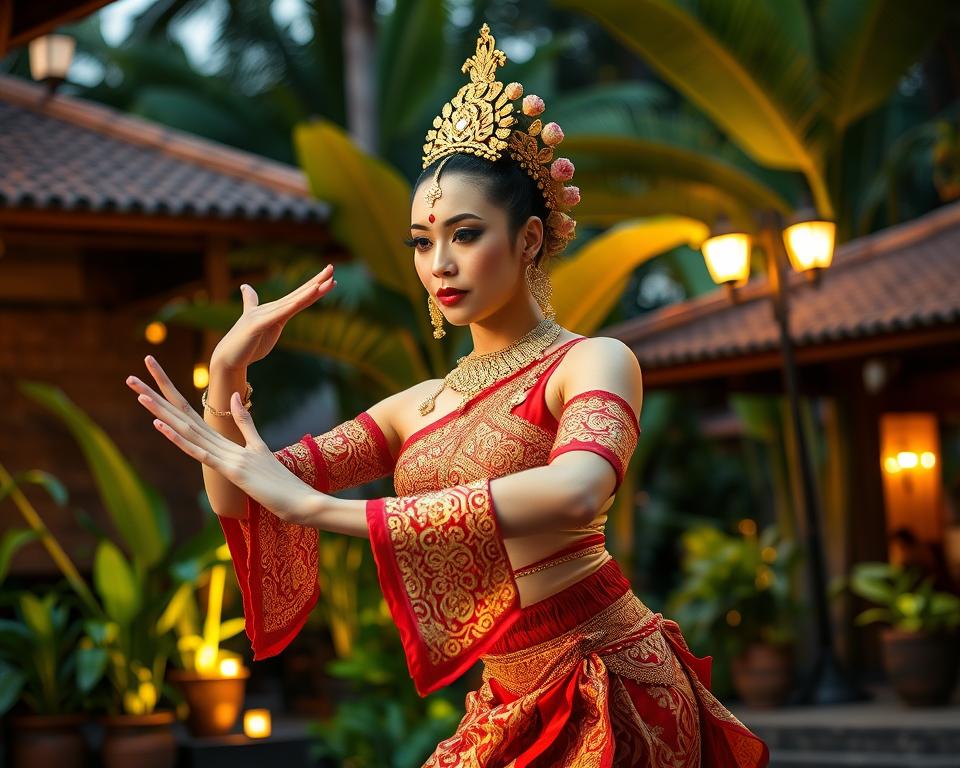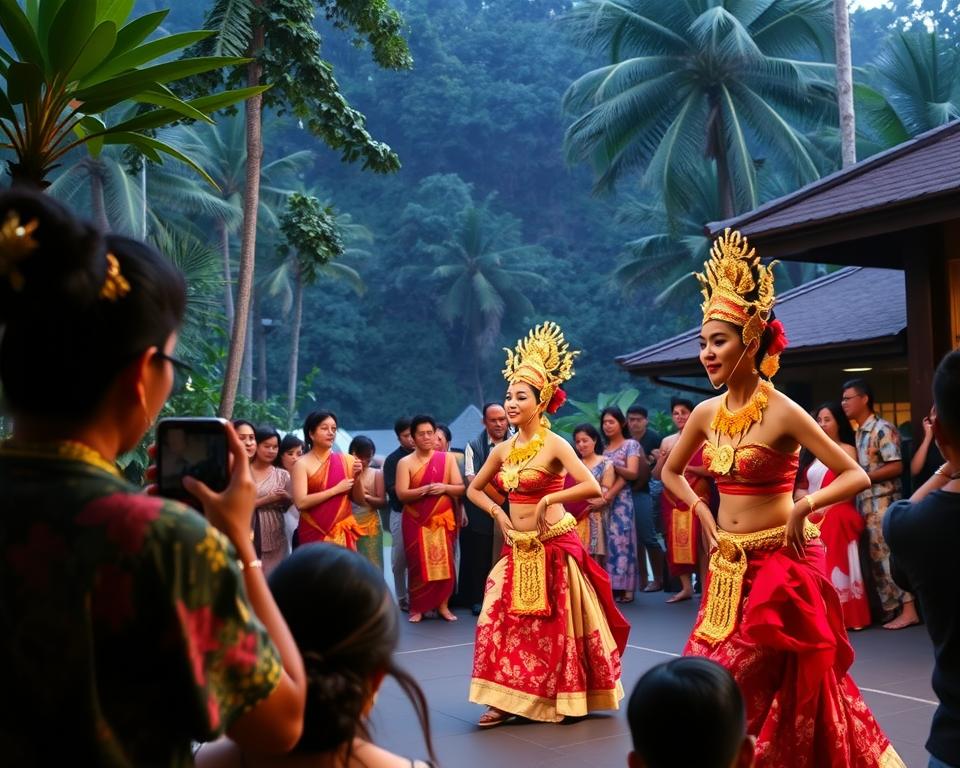
Legong Dance: Experience Bali’s Enchanting Dance of Elegance
Experience the Magic of Legong Dance in Bali: A Traditional Balinese Art
As the sun went down, it painted the sky orange and pink. A cool breeze moved through Ubud’s lively streets. Young Balinese girls in beautiful costumes and golden headdresses got ready. They were about to perform the Legong Dance, a key part of Balinese culture. Their elegant hands moved together, showing this dance’s grace and deep stories. This wasn’t just a show; it was a tribute to a loved culture that wins hearts worldwide.
The Legong Dance is known for its gentle and elegant movements1. It often features three young girls, two as Legongs and one as an attendant. They are chosen when very young, sometimes at five years2. Their dancing feet share tales of love, involving princesses and princes, with the sound of a gamelan orchestra1. When you visit Bali, seeing the Legong Dance lets you into the colourful world of Balinese culture. It shows how much the community wants to keep their art alive.
If you’re going to Bali, knowing this Bali dance is key. For more on Ubud, including other cultural sights, check out this guide.
Key Takeaways
- Legong Dance is a signature performance of Bali, showcasing intricate footwork and expressive gestures.
- Typically performed by young girls, the dance features themes of love and romance intertwined with local folklore.
- It has become a cultural emblem of Bali, regularly performed for tourists to experience traditional dance performances.
- Audiences can often catch Legong performances in Ubud’s royal palace and other cultural venues across Bali.
- The training for young dancers starts early, ensuring that traditions are passed on through generations.
Introduction to Balinese Dances
Balinese dance shows the heart of Bali’s culture, tightly linked with its Hindu beliefs. There are different dance types, each with its own role in the society. These range from holy (wali), to ceremonial (bebali), to everyday (balih-balihan) dances. Each kind has special purposes and shows the richness of Balinese life. They keep old customs and community values alive3.
Dance in Bali has a deep spiritual meaning. Dancers act as channels for divine power, using meaningful moves. This mix of spirit and dance follows the “Rwabhineda” idea. It aims for harmony in mind, body, and soul4.
Kids start learning dance when very young, often at seven years old. In Denpasar, about twenty-four schools teach dances like Legong to young girls5. Balinese dance has many styles, each telling mythical and adventurous stories through performances.
What is Legong Dance?
Legong Dance is a beloved Balinese traditional dance. It’s known for its beautiful movements and deep cultural importance. It typically features three young girls dancing. One plays a princess, another a king, and the third acts as a servant and a bird. The Legong Dance is performed during special events. It combines elegance and storytelling, deeply rooted in Balinese history.
Definition and Characteristics
Legong Dance is art that tells a story through amazing choreography. It’s known for its gentle movements, expressive hands, and complex footwork. The dance looks even more magical under the moonlight. It’s set to the sounds of gamelan music, especially the soft Semar Pagulingan6. Dancers express emotions and stories with their precise movements. They often draw inspiration from the tales of Prince Panji from East Java7.
Significance in Balinese Culture
In Balinese culture, Legong Dance is very important. It links people to their traditions and spiritual beliefs. Initially, it entertained kings or royal visitors, showing its historic roots6. Today, it keeps its cultural value alive. Performances bring the community together, boosting pride and identity. Over time, Legong Dance has changed. Yet, it stays true to its origins, celebrating Balinese heritage8. Legong keeps connecting people by blending old stories with current life. It creates a strong sense of togetherness and unity.
The Origins of Legong Dance
The Legong Dance is a treasured classic in Bali with a deep history. It started in the 19th century as royal fun. Kings and queens of Bali enjoyed it behind palace walls.
Historical Background
This dance tells stories through its moves, inspired by dreams and legends. Girls start learning it at the age of five. They work on becoming flexible to do the dance’s detailed steps. The Legong Dance was first made for Balinese nobles, which made it very important910.
The Connection to Royalty
Legong was first a royal show, making it a key art of Indonesia. It was not just fun but showed Balinese spirit and feelings. The dance has moved from palace shows to being seen by everyone9. Now, tourists in Bali often see the Legong Dance10.
The dance’s story keeps being told. It shows how art and Balinese kings are linked. This helps us understand Balinese dance’s origins.
Legong Dance: The Dance of the Virgins
The Legong Dance is really special, mainly done by young girls. They call it the *dance of virgins*. Girls from five to fourteen years old perform it. They show the beauty and grace of Balinese culture. Through their dance, they share stories of femininity and beauty. This is something everyone in Bali respects. These dancers showcase their amazing skills and the arts of Bali11.
Significance of Young Performers
Young girls in Legong are like cultural heroes. They help keep Bali’s traditions alive through their dance. They learn to show deep feelings with their detailed moves and looks. This way, they build a strong bond with their roots. Every dance is full of the spirit of Bali. It captures the hearts of people everywhere.
Training and Selection Process
Becoming a Legong dancer starts very early. Training kicks off at around five years old. It’s tough and needs both body skills and a focused mind. They pick dancers based not just on how they look but also on how well they dance. This ensures only the best get to be Legong dancers12. They work very hard for many years to perfect their art. This hard work keeps the Legong dance pure and showcases the dancers’ commitment.

Different Variants of Legong Dance
The Legong Dance has many forms, with Legong Kraton and Legong Ramayana being the most famous. These dances show the beauty of Balinese culture through their stories.
Legong Kraton and Legong Ramayana
Legong Kraton is known as “Dance of the Royal Palace.” It features complex dance moves linked to royal events. It’s performed by three young girls who show their skill and beauty8. Legong Ramayana, on the other hand, tells stories from the Ramayana epic. It uses dance and drama to share important tales13. Both highlight the talent needed in Balinese dance, adding to its culture14.
Regional Variations Across Bali
Besides Legong Kraton and Ramayana, Bali has other local Legong Dance styles. These versions include local legends and styles. Some may have unique costumes or moves that show local beliefs, keeping the dance alive in Bali’s culture.
Tourists in Bali should check out these variations of Legong in Bali. Along with other dances like Barong and Kecak, they show Bali’s creative side. They are key for visitors looking to learn about Balinese culture8.
The Performance: What to Expect
Going to a Legong show is a special way to see Balinese culture. You will see amazing dances that grab your attention. The dance moves tell stories with emotion6.
The dancers work together in an amazing way. This makes the show unforgettable.
Stylised Movements and Expressions
Legong Dance mostly has women dancers in beautiful costumes. They use detailed hand movements and fast steps. They also use fans to show different characters and emotions in the dance6.
These dances are not just for fun. They are an important part of Bali’s traditions.
Music Accompaniment and Gamelan Orchestra
A gamelan orchestra fills the show with wonderful sound15. The music goes well with the dance moves16.
Traditional Balinese instruments create unique rhythms. These sounds make you feel the deep emotions of the dance. It’s like being in a magical part of Bali.

The Costumes of Legong Dance
The Legong Dance is known for its beautiful moves and the amazing Legong Dance costumes. The outfits show off traditional Balinese culture and elegance.
Details of Dancer Attire
Every Legong dancer wears a special costume that shows their uniqueness17. The outfit includes a fancy lamak (breast cloth), a legong headpiece, and eye-catching subeng earrings18. These parts help the dancer tell a story.
The fabrics, like songket or ikat, are woven by hand17. This shows the deep tradition behind making these costumes. The colours are chosen to fit the character’s role, showing a lot of thought in the design.
Role of Accessories in the Dance
Accessories are key in Legong Dance for looks and the dance itself. Sparkly jewellery and hand-fans help tell the story with movement18. Every detail, from embroidery to beads, shows the skill in making dance accessories17. These pieces add more beauty to the dancer’s outfit and the dance’s story.
The Legong Dance Storylines
The Legong Dance is much more than just a show. It tells Legong Dance stories from deep Balinese legends. Every dance shares exciting stories of love, battles, and teachings. It shows the folklore themes in Legong Dance. From the young age of five, girls start to perform. Their movements express various characters, letting viewers feel the story deeply. The tradition of Legong Dance has a long history. It started with a King of Sukawati, I Dewa Agung Made Karna, who was in power from 1775 to 1825 AD. This history shows how dance traditions change but still respect their roots19.
Common Tales and Themes
Legong Dance usually tells of princesses, heroes, and the fight between good and bad. These stories are full of narrative elements from Balinese culture. They draw viewers in by showing each character’s emotional journey. Often, these tales talk about love and sacrifice. They reflect the deep and complex parts of human life and morals.
The Adaptation of Folklore in Dance
Changing folklore to fit Legong Dance is crucial. It helps keep these old stories interesting for people today. Artists mix traditional dancing with new ideas. This keeps the stories alive for the youth, connecting them to their culture. Folklore in dance is more than fun. It helps keep culture alive. Ubud is key to this vibrant dance scene. It’s home to famous spots like Ubud Palace and Saraswati Temple. There, people can see the beauty of Balinese culture and its famous dances8.
Venues for Experiencing Legong Dance
Watching Legong Dance in Bali is a top cultural experience. It has detailed moves and bright costumes. Many places across Bali host this magical show, especially in Ubud. This area blends tradition with beautiful buildings and greenery.
Popular Locations for Performances
Top spots for Legong Dance include Ubud Royal Palace, Taman Saraswati Temple, and Agung Rai Museum of Art. Each place has a special feel that makes the show even better. At Ubud Palace, you can see Legong Dance every night at 7:30 PM20. The dancers wear amazing costumes and look stunning. For a cozier vibe, Kunyit Restaurant has Legong and Barong Dance shows. They are on Saturdays at 7 PM20.
Tips for Attending a Legong Dance
It’s good to get there early for the best seats, especially when lots of tourists are there. Understanding the dance’s story makes the show more interesting. This turns a pretty dance into a great cultural journey. Bali dances usually last about 60 minutes. Tickets are around $7 USD. This makes it easy for everyone to see21. Being quiet and not using flash photos shows respect for this amazing art.
If you want to know more about Balinese shows, check out this detailed guide on Balinese dances in Bali. For those interested in dinner shows, this is very helpful. Another great place is the Sacred Monkey Forest Sanctuary2120.
Legong Dance in Modern Tourism
Legong Dance tourism has changed a lot over the years. It went from a royal show to a lively attraction for global visitors. The evolution of Legong performance shows cultural shifts in Bali. The dance has changed to fit modern times but kept its main features. This change made the dance more popular and helped it stay alive.
Transformation Over the Years
The Legong dance began in the early seventeenth century. It first featured young boys but later changed to female dancers. Now, women aged 18 to 30 mainly perform it2223. Performances are about 1½ hours long. They fit tourist schedules and mix old and new23. Old stories, like the famous Prince Panji tales, are still told. Yet, the dance has changed to interest today’s audiences22.
Status as a Cultural Symbol of Bali
Legong is a key cultural symbol in Bali. It highlights the island’s rich arts and Bali’s identity. It became well-known globally since the 1930s24. Now, you can see Legong at many cultural festivals. It helps people, both locals and tourists, learn about Balinese heritage. Local groups and those started by foreigners keep the dance going. They help Legong grow while staying true to its roots24. Legong’s important role in sharing Balinese culture worldwide continues.

Community Involvement and Impact
Local communities play a key role in keeping the Legong Dance alive. They form dance groups to train young performers. This helps to continue this beloved art form. Villages often host dance shows, merging local culture and tourism, and create pride. Through these efforts, they follow a community-based tourism approach that boosts the local arts while promoting self-rule.
Role of Local Communities in Preservation
Local communities help save Legong Dance and other Balinese dances. They see it as their duty. UNESCO lists Balinese dance as important cultural heritage. Local groups train young dancers to keep these traditions alive. Dance events help the community celebrate its culture. They also let visitors experience Bali’s rich heritage25.
How Legong Dance Shapes Community Identity
Legong Dance does more than entertain; it brings the community together. It allows villagers to connect with each other and visitors. Dance events turn into important cultural celebrations. They help keep local traditions in the minds of everyone. Plus, they make sure the next generations keep these practices alive2627.
| Aspect | Description | Impact on Community |
|---|---|---|
| Training | Young dancers undergo rigorous training within their communities. | Ensures preservation of Legong Dance traditions. |
| Performances | Host village events that feature Legong Dance. | Promotes local pride and community engagement. |
| Tourism | Incorporation of cultural dance in local tourism. | Supports economic development and cultural education. |
| Cultural Heritage | UNESCO recognises multiple forms of Balinese dance. | Strengthens community identity through cultural practices. |
Conclusion
The Legong Dance is a key part of Balinese culture. It wows people with its detailed moves and stories. This art is old yet talks about local values and spiritual beliefs.
The dance has changed over time. It has adapted to new influences while keeping its important qualities. This shows the strength of Indonesian heritage.
Local communities work hard to keep Legong alive. This makes sure it stays a big part of Bali’s culture. People from everywhere can see this amazing dance. They learn about Bali’s rich arts this way. The Sacred Monkey Forest is a great place for more Balinese experiences.
The Legong Dance shines as Bali’s soul lives on. Balinese shows, like Legong, highlight the value of sharing art. They keep local and global hearts captured. This way, its beauty lasts forever28.
FAQ
What is Legong Dance?
Legong Dance is a beautiful traditional dance from Bali. It’s known for its grace and complex movements. The dance shows off Bali’s art, spirituality, and was first performed in royal courts.
Who performs Legong Dance?
Young girls, aged five to fourteen, usually perform Legong Dance. They show grace and elegance, important in Balinese culture.
What are the main characteristics of Legong Dance?
This dance is famous for its gentle movements and detailed hand movements. Dancers also use facial expressions and footwork to tell stories. They do this all to gamelan music.
Where can I watch a Legong Dance performance?
You can watch Legong Dance in many places in Bali. Some popular spots are the Ubud Royal Palace, Taman Saraswati Temple, and Agung Rai Museum of Art.
How does one train to become a Legong dancer?
Becoming a Legong dancer takes hard work from a young age. Dancers train a lot to get better at their technique, remember routines, and perform well.
What stories are typically told through Legong Dance?
Legong Dance shares exciting stories from folklore, mythology, and history. These stories often talk about love, battles, and sad tales that touch the audience.
How has Legong Dance evolved over time?
Legong Dance started in royal courts but is now enjoyed by people from all over as a tourist attraction. This has happened while keeping the dance’s traditional roots.
What role does music play in Legong Dance?
A live gamelan orchestra plays with Legong dancers. The music’s rhythms and tunes add feeling to the dance, guiding the dancers.
Are there different variants of Legong Dance?
Yes, there are many types of Legong Dance. The most famous are Legong Kraton and Legong Ramayana, each with its own style and story techniques.
Why is Legong Dance significant to Balinese culture?
Legong Dance is crucial to Balinese tradition and their spiritual life. It keeps the community together and saves ancient stories for the next generations.
Q: What is the story behind the Legong Dance in Bali?
A: The story behind the Legong Dance in Bali is rich and intricate, often revolving around tales of love, sacrifice, and mythology. The dance is believed to have originated from the court performances in the kingdom of Lasem and features themes such as the legend of Princess Rangkesari and her lover, King Lasem.
Q: What is the Legong Keraton dance?
A: The Legong Keraton dance is a specific style of Legong Dance performed in Bali, characterized by its graceful movements and the involvement of three dancers. It is often performed at royal ceremonies and is known for its intricate finger gestures and facial expressions.
Q: How does the Legong Dance in Bali differ from the Kecak Fire Dance?
A: While both the Legong Dance and the Kecak Fire Dance are traditional Balinese performances, they differ in their themes and styles. Legong Dance focuses on courtly love and drama, often featuring the story of Rangkesari, while Kecak Fire Dance is more of a spiritual performance involving a group of male singers who chant “cak” and tell the story of the Ramayana.
Q: What are some key elements of the Bali Legong Dance?
A: Key elements of the Bali Legong Dance include the use of intricate finger gestures, expressive facial expressions, and vibrant costumes. The dance is also accompanied by traditional gamelan music, enhancing the visual and auditory experience.
Q: Why is the Legong Keraton dance considered one of Bali’s most visually alluring royal dances?
A: The Legong Keraton dance is considered one of Bali’s most visually alluring royal dances due to its elaborate costumes, the fluidity of movements, and the dramatic storytelling. The combination of the dancers’ grace and the detailed music creates a captivating experience for the audience.
Q: What is the significance of the Condong in the Legong Dance?
A: The Condong serves as the female lead dancer in the Legong Dance, often representing a character that guides the audience through the performance. Her role is crucial as she helps convey the story through her movements and expressions, embodying the essence of the narrative.
Q: Can tourists experience the Legong Dance during a Bali tour?
A: Yes, tourists can experience the Legong Dance during a Bali tour. Many cultural performances are held in various venues across Bali, where visitors can enjoy the dance alongside traditional Balinese cuisine and other artistic showcases.
Q: What are the main stories depicted in the Legong Dance?
A: The main stories depicted in the Legong Dance often revolve around the themes of love and mythology, particularly focusing on the tale of Princess Rangkesari and her trials with King Lasem. Other narratives may also involve spiritual elements, such as the Sang Hyang Legong, which showcases the connection between the divine and the human experience.
Q: How does the Keris Dance relate to the Legong Dance?
A: The Keris Dance, while distinct, is often performed alongside the Legong Dance in Balinese ceremonies. It features the use of the keris (a traditional dagger) and can complement the storylines seen in the Legong performances, enhancing the overall cultural experience.
Source Links
- Bisma Eight Ubud | Luxury Boutique Hotel & Villas In Ubud, Bali | – Unveiling the Origins of Bali’s Most Popular Traditional Dances: A Cultural Journey – https://bisma-eight.com/news/unveiling-the-origins-of-bali-most-popular-traditional-dances-a-cultural-journey
- Blog | TheUdayaResort – https://theudayaresort.com/article.php?id=2012181502
- Balinese dance – https://en.wikipedia.org/wiki/Balinese_dance
- Balinese Dance: The Spiritual Language of the Island – https://warriorsdivine.com/blogs/the-path/balinese-dance-the-spiritual-language-of-the-island?srsltid=AfmBOooSSQMVG94jp_ZFaMk1TYPoWOHUOXCKA8O8_-ADlR1y2N40pdk6
- Balinese Dances – Murni’s in Bali – https://www.murnis.com/culture/balinese-dances/
- Bali Legong Dance – https://www.baligoldentour.com/legong-dance.php
- Legong, Dance of the Maidens – Asian Traditional Theatre & Dance – https://disco.teak.fi/asia/legong-dance-of-the-maidens/
- Balinese Dances and their Stories – https://bali-culturetours.com/blog/balinese-dances-and-their-stories/
- Legong Dance in Bali – Balinese Traditional Performance – https://balicheapesttours.com/legong-dance.html
- Legong Dance Bali: Where To See The Best Dance Performances And More – https://finnsbeachclub.com/guides/legong-dance-bali/
- Legong: Dance of the Virgins – https://silentfilm.org/legong-dance-of-the-virgins/
- Legong (film) – https://en.wikipedia.org/wiki/Legong_(film)
- BALINESE DANCE | Facts and Details – https://factsanddetails.com/indonesia/Minorities_and_Regions/sub6_3h/entry-4030.html
- Balinese Dance: History, Types, and Where to See It – Ubud Villas Rental – https://www.ubudvillasrental.com/balinese-dance-history-and-values-behind-its-beauty/
- Balinese Dance With Kids – Artsplorers – https://www.artsplorers.com/artsplorers-discover-balinese-dance/
- Traditional Balinese Dances in Ubud – Mara River Safari Lodge – https://www.marariversafarilodge.com/traditional-balinese-dances-in-ubud/
- A life of leghngas – https://swarnasaris.com/blogs/news/a-life-of-leghngas
- Legong dancer – https://artdecobali.blog/portfolio/legong-dancer/
- Legong Dance | The Classical Balinese Dance Performance – https://www.balifulldaytour.com/legong-dance.php
- 14 Places to Enjoy Balinese Dances in Bali – https://whatsnewindonesia.com/bali/ultimate-guide/things-do/14-places-enjoy-balinese-dances-bali
- Balinese Dance: Where to See Traditional Bali Dance Performances in Ubud — Travlinmad Slow Travel Blog – https://www.travlinmad.com/blog/2015/9/where-to-see-balinese-dance-in-bali
- Get to Know Bali Indonesia Traditional Dance: Legong Dance – at jooi.id – https://jooi.id/travel-inspiration/get-to-know-bali-indonesia-traditional-dance-legong-dance
- The Twin Mirrors of Bali’s Legong Dance – https://medium.com/@indoneo/the-twin-mirrors-of-balis-legong-dance-4f43f425349e
- The Role of Westerners in the Conservation of Legong Dance – https://quod.lib.umich.edu/c/ca/7523862.spec.305/–role-of-westerners-in-the-conservation-of-legong-dance?rgn=main;view=fulltext
- The Essential Guide To Balinese Dance – https://theculturetrip.com/asia/indonesia/articles/the-essential-guide-to-balinese-dance
- Community-based Tourism (CBT) in Bali – https://sites.utexas.edu/internationalplanning/case-studies/community-based-tourism-cbt-as-alternative-development-in-bali/
- Beyond Cultural Tourism: Experiencing the Arts in Bali – Association for Asian Studies – https://www.asianstudies.org/publications/eaa/archives/beyond-cultural-tourism-experiencing-the-arts-in-bali/
- Traditional Dance Bali: Embracing The Cultural Treasure – Ubud Villas Rental – https://www.ubudvillasrental.com/traditional-dance-the-cultural-treasure/